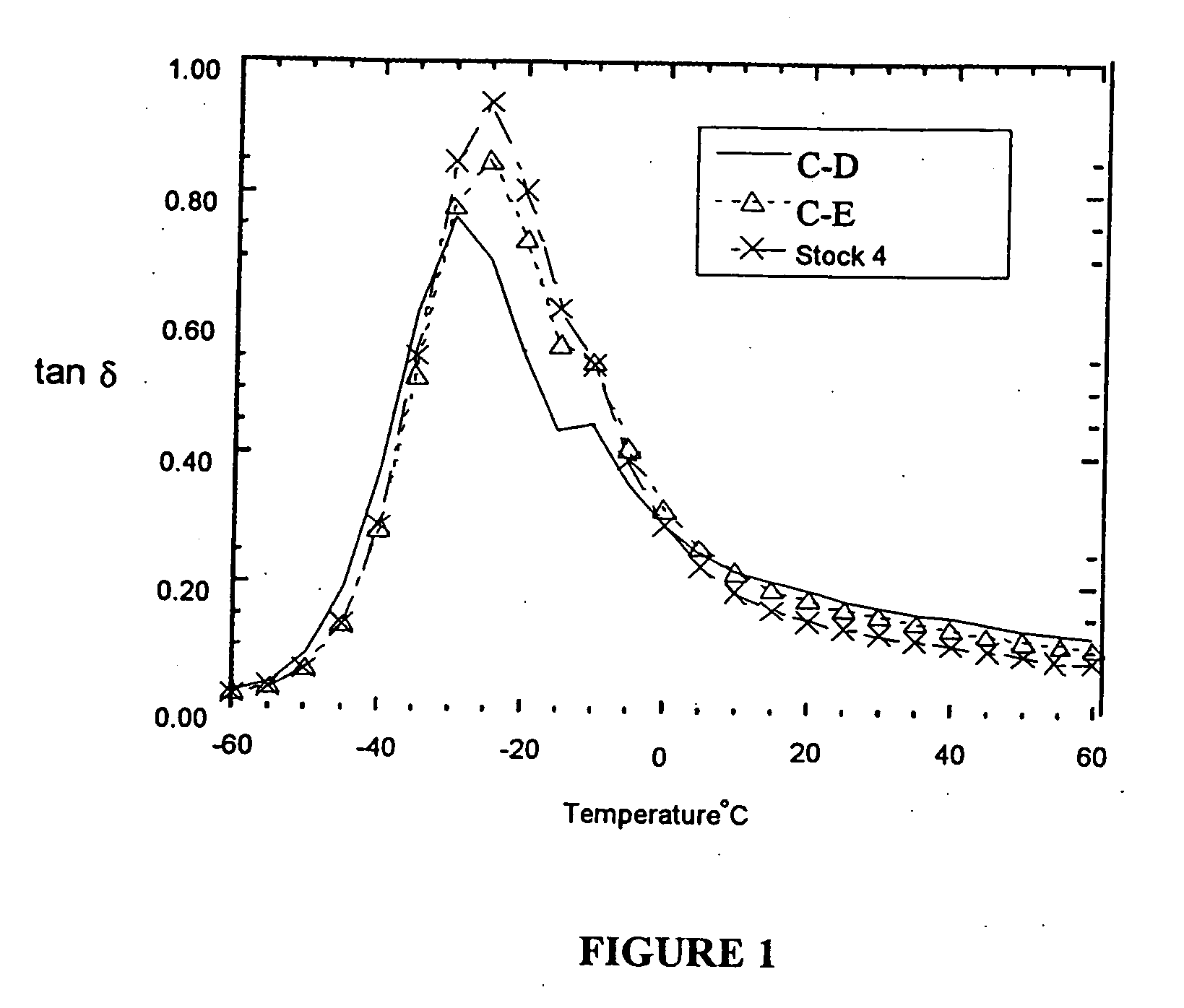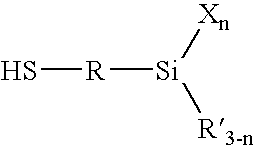Silica-reinforced rubber compounded with an alkoxysilane and a strong organic base
a technology of organic base and rubber, which is applied in the field of vulcanizable elastomeric compounds, can solve the problems of poor silica dispersion and high compound viscosity, rigid uncured compound that is difficult to process, and disadvantages of bifunctional silica coupling agents, so as to reduce the evolution of ethanol, and accelerate the curing rate
- Summary
- Abstract
- Description
- Claims
- Application Information
AI Technical Summary
Benefits of technology
Problems solved by technology
Method used
Image
Examples
example 1
Synthesis of a Mixture of Tin-Coupled and TEOS-Terminated SBR Polymer
[0076] This polymer was a mixture containing about 45% TEOS-terminated polymers and about 35% tin-oupled polymer. This polymer was used to prepare the invention rubber stocks designated “Stock 1 ” and “Stock 2” and comparison stocks “C-A” and “C-B” in Table 3.
[0077] To a one gallon reactor was charged 0.07 kg of hexane, 0.41 kg of 33.0 percent by weight styrene in hexane, and 1.74 kg 22.4 percent by weight butadiene in hexane. Then, 0.28 ml of 1.6 M 2-2′-di(tetrahydrofuryl)propane in hexane, 0.63 ml of 0.6 M potassium t-amylate in hexane, 1.42 ml of 3.54 M hexamethyleneimine and 3.93 ml of 1.6 M n-butyl lithium in hexane were charged into the reactor, and the jacket temperature was set at 122° F. After 97 minutes, 2.20 ml of 0.25 M tin tetrachloride in hexane was added to the reactor. Ten minutes later, 2.53 ml of 1.12 M tetraethoxyorthosilicate was added to the reactor. After 15 additional minutes, the cement wa...
example 2
Tin-Coupled SBR
[0078] A tin-coupled polymer sold commercially by Bridgestone / Firestone Corporation was obtained. The properties of the SBR tin-coupled polymer are: ML1+4+72; styrene content=20%; vinyl content=59%; and Tg=−33° C. This polymer was used to prepare the invention rubber stock designated “Stock 3” and comparison stock “C-C” in Table 3.
example 3
[0079] In order to demonstrate the methods of preparation and properties of the vulcanized elastomeric compounds of the invention, six stocks of rubbers were prepared using the compounding formulation and mixing conditions shown in Tables 1, 2 and 3. Stocks 1, 2 and 3 were compounded with DPG in the master batch to a temperature of 175° C. to 180° C. In the master batch stage, the DPG acts as a catalyst for the alkoxysilane-silica reaction. Comparison stocks C-A, C-B and C-C were compounded with DPG in the final mixing stage to a temperature of 105° C. where, in combination with the curing agents, DPG serves its customary role as a secondary accelerator.
[0080] Stocks 1 and 2 and comparison stocks C-A and C-B were prepared with the tin coupled and TEOS-terminated polymers described in Example 1. Stock 1 is an invention stock prepared by compounding the polymer with silica, the alkyl alkoxysilane, OTES, and DPG at high temperature in the master batch. C-A is a comparison stock prepar...
PUM
| Property | Measurement | Unit |
|---|---|---|
| temperature | aaaaa | aaaaa |
| tan δ | aaaaa | aaaaa |
| tan δ | aaaaa | aaaaa |
Abstract
Description
Claims
Application Information
 Login to View More
Login to View More - R&D
- Intellectual Property
- Life Sciences
- Materials
- Tech Scout
- Unparalleled Data Quality
- Higher Quality Content
- 60% Fewer Hallucinations
Browse by: Latest US Patents, China's latest patents, Technical Efficacy Thesaurus, Application Domain, Technology Topic, Popular Technical Reports.
© 2025 PatSnap. All rights reserved.Legal|Privacy policy|Modern Slavery Act Transparency Statement|Sitemap|About US| Contact US: help@patsnap.com


